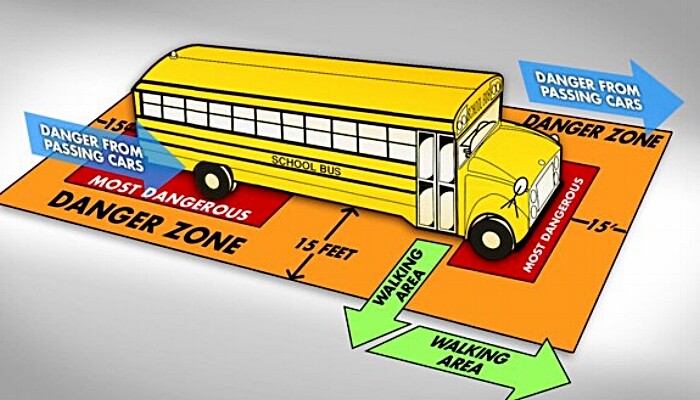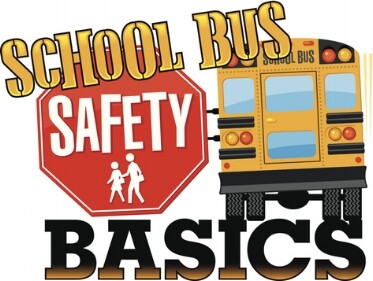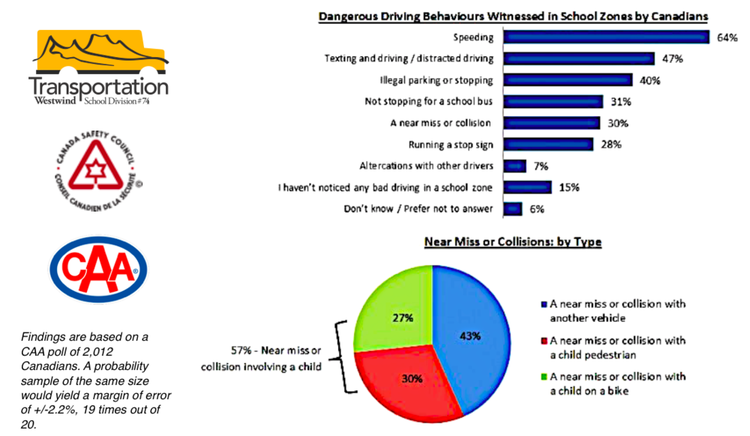
Bus Safety
The most dangerous part of the school bus ride is getting on and off the school bus. The loading and unloading area is called the “Danger Zone”.
The “Danger Zone” is the area on all sides of the bus where children are in the most danger of not being seen by the driver (ten feet in front, ten feet on either side of the bus, and ten feet behind are all areas where a child may be in the driver’s blind spot). It only takes a second to lose sight of a student if a driver becomes distracted by students on board the bus. When training our bus drivers we stress the importance of safe loading and unloading procedures. This is where our drivers need to be fully focused and cannot be distracted by students or parents.
It is important to have parents understand that drivers need their cooperation to be fully focused at this time, by not parking and staying away from the loading and unloading zones. Please park well away from loading zones at all times.
- It is also important to instruct students in the proper procedure for loading and unloading.
- Be cautious when carrying loose papers or books which might drop near the bus – we encourage students to use a book bag.
- Be aware of the dangers of clothing, book bag, backpack, and jacket strings/straps that could become entangled in the doorway of the school bus.
- Wait in an orderly fashion safely back from roadway or pick-up zone. Students need to be at their stop three to five minutes early. The time you have been given for pick-up is the time the bus departs from your stop.
- Board the bus in single file; use the handrail so you don’t trip on the steps.
- Sit down right away, so you don’t fall when the bus starts moving.
- Sit back in your seat, face forward and keep your feet to the front.
- Keep the aisle clear of feet, backpacks, books, etc.
- Talk quietly in order that you do not distract the driver. Remember, it’s the driver’s responsibility to keep you safe!
- Keep your head, arms, and hands inside the bus, not out the window.
- Never throw things in the bus or out the window.
- Wait for the bus to come to a complete stop and the doors to open before you leave your seat.
- After leaving the bus, take five giant steps away from the bus so you are out of the Danger Zone and in a safe spot.
- If you need to cross in front of the bus make sure you look at the driver for a signal that it is okay for you to cross the roadway.
Pop Quiz PSA

School Zones
Motorists abiding by the laws and being vigilant with student pedestrians and bicyclists will help ensure that children reach their destinations safely by following these guidelines:
- Abide by the school bus traffic laws.
- Keep a watchful eye for children running to catch their bus. They have been known to pay little regard for their own safety and may dart out in traffic.
- Respect the crossing guards and slow down in school zones.
- During the school year, be especially cautious during periods of the day when students are travelling to and from home.
- Keep a watchful eye for cyclists and pedestrians on roadways.
- When turning at intersections watch out for students using the crosswalks
- Teach your own children about safe conduct in roadways and on school buses.

Canadians see dangerous driving in school zones across the country
Nearly two thirds (64 percent) of Canadians have witnessed at least one dangerous driving practice in school zones, according to a poll released by the Canadian Automobile Association as part of National School Safety Week.
Almost one third (30 percent) of drivers reported witnessing a near miss or collision in a school zone, more than half of which involved a child. Drivers also said they witnessed speeding, texting while driving or distracted driving, people not stopping for a school bus, and running a stop sign (see full chart below).
“The safety of our children, and all road users, in school zones is a top priority for CAA,” says Jeff Walker, vice-president, public affairs, CAA National. “Driving with caution in school zones is a message every Canadian driver needs to keep in mind all year round.”
Parents and drivers can do their part to keep school zones safe by respecting the speed limits in school zones, and by eliminating distractions such as cell phone use. CAA also encourages parents to park a block away and walk to school, if possible, to reduce congestion and make school zones safer.
“School zones have changed a lot in a generation,” says Walker. “Fewer children walk to school, which means more cars and busses crowd a small space in a relatively short period of time, making school zones harder to manoeuver safely.”
Fully 4 out of 10 Canadians say they are witnessing more unsafe driving practices in school zones today than in the past.

National School Safety
Everyone using Canadian roadways has a role to play concerning safety around school-aged pedestrians, cyclists and school buses. The rules governing the behaviour of drivers sharing the road with school buses are designed to give the best possible outcome of safe boarding, riding and exiting of school bus passengers. With education, awareness and enforcement, children can rely on what has been proven to be the safest method of transportation. Advancements in engineering have contributed to improvements in safety features such as Stop Arms, which extend at the front of the buses to enhance the visibility of children and strategically placed mirrors to improve the field-of-view around the bus.
We rely on more than 20,000 school buses in Canada to bring our children to and from school every day. The buses are readily recognizable with their bright yellow colour, flashing lights and distinct shape. They carry students of many ages, sizes and stages of development. They make multiple stops, short runs and long runs along rural highways.
For the occasion of our National School Safety Week, Canada Safety Council would like to remind motorists sharing the roads with school buses and school-aged pedestrians and bicyclists, of the road safety rules in order to ensure the safe transportation of our children.
The Highway Traffic Act in each province and territory states that every driver approaching from both directions towards a school bus that has its overhead red signal-lights flashing, must stop and shall not proceed until the bus moves or the overhead red signal-lights have stopped flashing (except on highways separated by a median strip, whereby oncoming traffic is not required to stop). It is also worth noting that most school buses are required by law to stop at all railway crossings. Motorists should be prepared to stop.




